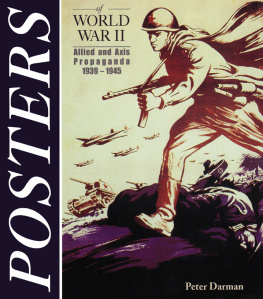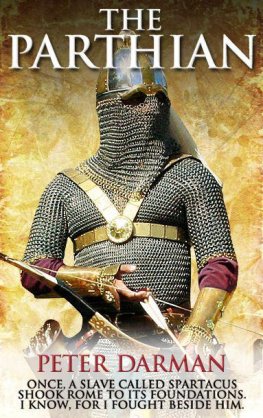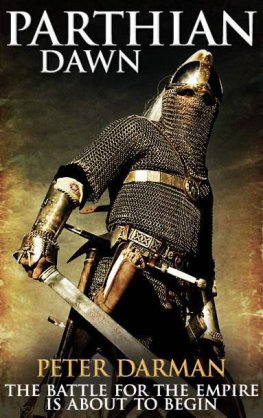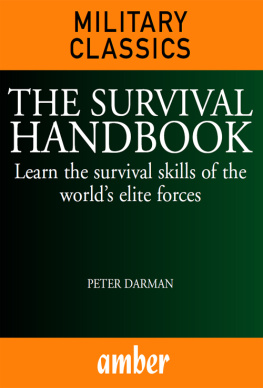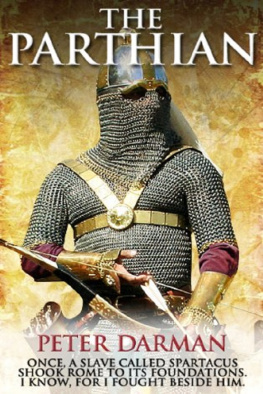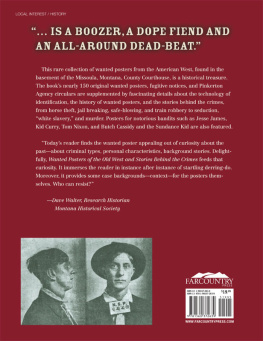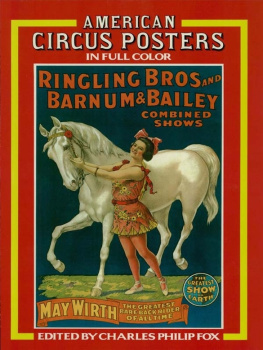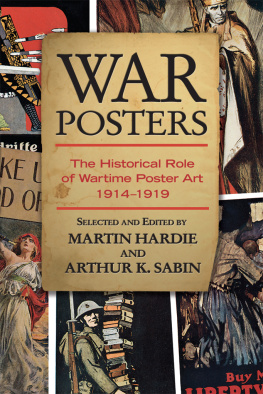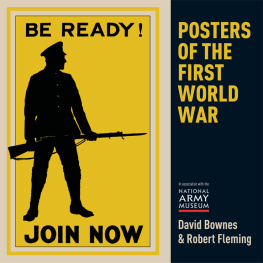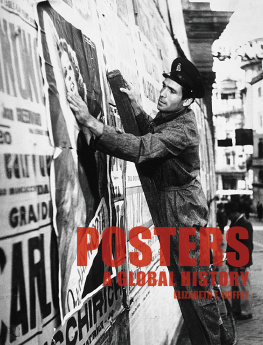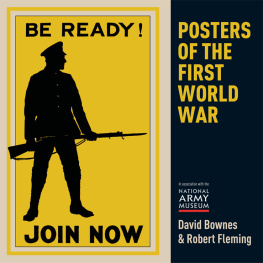Peter Darman - Posters of World War II
Here you can read online Peter Darman - Posters of World War II full text of the book (entire story) in english for free. Download pdf and epub, get meaning, cover and reviews about this ebook. publisher: Pen and Sword, genre: Politics. Description of the work, (preface) as well as reviews are available. Best literature library LitArk.com created for fans of good reading and offers a wide selection of genres:
Romance novel
Science fiction
Adventure
Detective
Science
History
Home and family
Prose
Art
Politics
Computer
Non-fiction
Religion
Business
Children
Humor
Choose a favorite category and find really read worthwhile books. Enjoy immersion in the world of imagination, feel the emotions of the characters or learn something new for yourself, make an fascinating discovery.
- Book:Posters of World War II
- Author:
- Publisher:Pen and Sword
- Genre:
- Rating:4 / 5
- Favourites:Add to favourites
- Your mark:
- 80
- 1
- 2
- 3
- 4
- 5
Posters of World War II: summary, description and annotation
We offer to read an annotation, description, summary or preface (depends on what the author of the book "Posters of World War II" wrote himself). If you haven't found the necessary information about the book — write in the comments, we will try to find it.
Posters of World War II — read online for free the complete book (whole text) full work
Below is the text of the book, divided by pages. System saving the place of the last page read, allows you to conveniently read the book "Posters of World War II" online for free, without having to search again every time where you left off. Put a bookmark, and you can go to the page where you finished reading at any time.
Font size:
Interval:
Bookmark:

POSTERS
_________________ _________________
of
WORLD WAR II

POSTERS
_________________ _________________
of
WORLD WAR II
Allied and Axis Propaganda 1939 1945

Peter Darman

Pen & Sword
MILITARY
This edition published in 2011 by
Pen & Sword Military
An imprint of
Pen & Sword Books Ltd
47 Church Street
Barnsley
South Yorkshire
S70 2AS
copyright 2008 Brown Bear Books Ltd
All rights reserved. Except for use in a review, no part of this
book may he reproduced, stored in a retrieval system,
or transmitted in any form, or by any means, electronic.
mechanical, photocopying, recording, or otherwise,
without prior permission of Brown Bear Books Ltd.
ISBN: 978-1-84884-433-9
Windmill Books Ltd
First Floor, 917 St. Albans Place
London, N10NX
Senior Managing Editor: Tim Cooke
Picture Research: Andrew Webb
Designer: Phillip Stonier
Production Director: Alastair Gourlay
Editorial Director: Lindsey Lowe
Printed and bound in China
PICTURE CREDITS
All images from The Robert Hunt Library except the following:
Australian War Memorial Art Images: 21, 32
Library of Congress: 49, 68, 74, 77, 117, 121, 122, 123, 124, 125, 126, 129, 130, 131, 132, 133, 134, 135,
137, 138, 139, 140, 144, 145, 146, 147, 148, 149, 153, 156, 157, 158, 159, 160, 161, 163, 164, 165, 166, 167,
169, 170, 171, 174, 175, 176, 177, 179. 182, 183, 184, 185, 187, 188, 189, 190, 191, 192, 194, 195,
196, 198, 199, 201, 203, 206, 207, 208, 209, 210, 211, 212, 213, 214, 215, 216, 217, 218, 219, 223
McGill University Library: 16, 17, 18, 19, 20, 27, 28, 38, 40, 43, 46
Randall Bytwerk: 3, 61, 62. 63, 64, 65, 66, 70, 71, 73, 78, 79, 80, 81, 82, 83, 84, 85, 91
Topfoto: 52, 53, 55, 56, 57
Page 2: A Soviet wartime poster celebrating the achievements of the Bolshevik Revolution.
Pen & Sword Books Ltd incorporates the Imprints of Pen & Sword Aviation, Pen & Sword Family History. Pen & Sword Maritime,
Pen & Sword Military, Wharncliffe Local History, Pen & Sword Select, Pen & Sword Military Classics.
Leo Cooper, Remember When. Seaforth Publishing and Frontline Publishing
For a complete list of Pen & Sword titles please contact
PEN & SWORD BOOKS LIMITED
47 Church Street, Barnsley, South Yorkshire, S70 2AS, England
E-mail: enquiries@pen-and-sword.co.uk
Website: www.pen-and-sword.co.uk
Contents
D uring World War II, all the warring nations produced thousands of posters to mobilize their respective population for the war effort. world War II was a total war, and thus required the total effort of not only members of the armed forces but also civilians on the home front. The poster was a simple yet powerful psychological aid to mobilizing the nation. Cheap, accessible, and ever-present, the poster was an excellent method of reaching every citizen. Whatever message a poster was conveyingpatriotism, the need for greater security, increased productionit was directed at every citizen, in or out of uniform. As a member of the American Office of War Information (OWI) stated during the war: We want to see posters on fences, on the walls of buildings, on village greens, on boards in front of the City Hall and the Post Office, in hotel lobbies, in the windows of vacant storesnot limited to the present neat conventional frames which make them look like advertising, but shouting at people from unexpected places with all the urgency which this war demands.
To be effective a poster needed to carry a simple yet powerful message, one that was easy to understand by everyone. Subtlety and sophistication were the enemies of an effective poster campaign. Adolf Hitler, head of the German Nazi Party and from 1933 leader of Germany, was under no illusion with regard to the intelligence of the masses: But since propaganda is not and cannot be the necessity in itself, since its function, like the poster, consists in attracting the attention of the crowd, and not in educating those who are already educated or who are striving after education and knowledge, its effect for the most part must be aimed at the emotions and only to a very limited degree at the so-called intellect.
This reasoning was duplicated in another totalitarian regime: the Soviet Union. Posters played a crucial part in the development of the Soviet regime, first by helping the Bolsheviks to win the Civil War, and then helping them to mobilize millions of people to fulfill agricultural and industrial schemes in the 1920s and 1930s. The poster campaigns were relentless and blunt, and in case anyone failed to get the message there was a vast internal security organizationthe NKVD (Peoples Commissariat for Internal Affairs)to deter any dissenters or slackers. Those who fell foul of the regime were sent to the Gulag, the vast network of labor camps that existed in the hinterland of the USSR. Once there, inmates carried on working to produce the goods the regime needed.
Once the war broke out in June 1941, the Soviets kept on mass-producing posters, but their message changed. The immediate aim was to defeat the fascist invader, though as German armies crashed into the Soviet Union in the summer of 1941 and neared the gates of Moscow, mobilizing the population to save the state itself became of crucial importance.
In the liberal democracies of Western EuropeBritain, France, and the Low Countriesposter designs were usually more restrained than those of the the totalitarian regimes, and indeed those produced during World War I. There were two reasons for this. First, there was the general postwar disillusionment after 1918, particularly after the exposure of fraudulent atrocity propaganda produced by both sides in the Great War. Thus propaganda was most effective when it was least propagandistic. Second, radio, film, and newspapers combined to reduce the overall importance of the poster. But the poster was still important for conveying simple, powerful messages.
Despite their different political ideologies, the Axis states, the Soviet Union, and the Western Allies all produced posters that had broadly similar themes. First was the appeal to patriotism. If World War II was a total war, then it was axiomatic that each participant had to convince the mass of its population to be loyal to the state. Patriotism was a prerequisite for the creation of vast conscript armies and mass mobilization of those who werent in uniform. Group loyalty was particularly important in the Western liberal democracies, as their governments were making wartime demands on the population that would not be tolerated in peacetime.
Patriotic posters made use of emotive symbols and emblems, such as the swastika in Nazi Germany and the Stars and Stripes in the United States. Many patriotic posters were merely recruitment aids for the armed forces, with state and party insignia repeated on the uniforms worn by the men and women featured in the posters. U.S. posters often added another dimension to the patriotic theme: freedom. This was a peculiar American trait and was lacking in posters produced by other Allied nations, and obviously did not figure in the posters of the totalitarian powers, where individual freedom was sacrificed for the good of the state. For the United States, which even in the dark days in late 1941 and early 1942 was never going to face the prospect of enemy forces fighting on home soil or its cities being bombed by fleets of enemy aircraft, patriotism alone was not enough to mobilize the masses. Freedom, especially freedom from tyranny, is a sentiment that runs deep in the American soul. The promise of bringing freedom and liberating oppressed people overseas was an ideology that many Americans embraced, and helped to convince the American public that the millions of servicemen being sent to Europe and the Pacific were fighting a worthy cause.
Font size:
Interval:
Bookmark:
Similar books «Posters of World War II»
Look at similar books to Posters of World War II. We have selected literature similar in name and meaning in the hope of providing readers with more options to find new, interesting, not yet read works.
Discussion, reviews of the book Posters of World War II and just readers' own opinions. Leave your comments, write what you think about the work, its meaning or the main characters. Specify what exactly you liked and what you didn't like, and why you think so.

